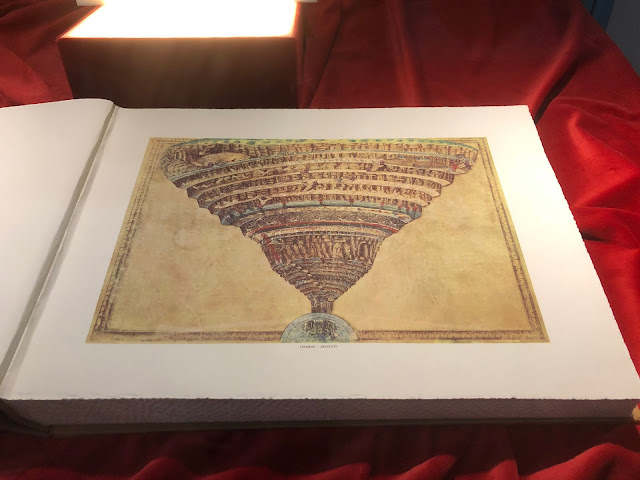【フィレンツェ】ダンテの家 『神曲』の世界 Firenze - Casa di Dante, La Divina Commedia
ダンテの家の内部は3階建てで、1階はショップ、2階と3階は、ダンテの生涯や彼が暮らしていた頃を中心としたフィレンツェの歴史などが様々な展示品で紹介されている。
特に、『神曲』についての展示が多く、古い『神曲』の本の展示、日本語をはじめとした各国に翻訳された『神曲』、その物語世界を紹介する展示などがあった。
日本語に訳された『神曲』は何度か読んだことがある。
最初は岩波文庫の山川丙三郎の古い文語調の訳で、その後、河出文庫の平川祐弘の訳や集英社文庫の寿岳文章の訳で読み、現在、手元には角川文庫の三浦逸雄の訳による『神曲』がある。
『神曲』は、地獄篇、煉獄篇、そして天国篇の3部構成になっている。
ダンテ自身は、この作品については、喜劇、コメディアとしていて、自ら『神曲』とは名付けていなかった。後にボッカッチョがこの作品を”神聖な(Divina)”と呼んで、それ以来、『神曲』(La Divina Commedia)と言われるようになったらしい。
ダンテ自身がこの物語の主人公で、古代ローマの詩人ウェルギリウスに導かれて、地獄や煉獄の世界を巡っていく。
若きダンテがその死を悼み、『新生』を捧げたベアトリーチェが、ダンテを天国に誘うという重要な役回りで登場する。
ダンテに敵対した人々や、ダンテによって悪人とされた人々が、地獄篇ではその行いとともに断罪される。そこには、『帝政論』で展開されたダンテの政治思想が反映されている。
全体が天国、煉獄、地獄という3部から構成されていること、前書きとなる部分を除ば、各部が33編で構成されているなど、3という数字が重要な意味を持っている。
主要な登場人物も、ダンテを含めてウェルギリウスとベアトリーチェという3人だ。
ダンテはこの『神曲』を1307年頃から書き始め、1321年に完成させたが、その年にマラリアにかかって命を落としている。
ダンテのフィレンツェを追放されてからの人生は、この『神曲』を書くための人生だったと言えるかもしれない。
The interior of Dante's house is three stories high, with shops on the first floor and various exhibits on the second and third floors, including the life of Dante and the history of Florence centered around the time he lived. There is.
In particular, there were many exhibitions about "La Divina Commedia", such as an exhibition of old "La Divina Commedia" books, "La Divina Commedia" translated into Japanese and other countries, and an exhibition introducing the story world.
I have read "La Divina Commedia" translated into Japanese several times.
At first, I read the translation of the old literary style of Heizaburo Yamakawa of Iwanami Bunko, then the translation of Sukehiro Hirakawa of Kawade Bunko and the translation of Bunsho Jugaku of Shueisha Bunko, and now I have the translation of Hayao Miura of Kadokawa Bunko. There is "La Divina Commedia" by.
"Divine Comedy" consists of three parts: Hell, Purgatory, and Heaven.
Dante himself described this work as a comedy and comedy, and did not call it "Divine Comedy" himself. It seems that Boccaccio later called this work "Sacred (Divina)", and since then it has been called "Divine Comedy" (La Divina Commedia).
Dante himself is the main character of this story, guided by the ancient Roman poet Virgil, touring the world of hell and purgatory.
Beatrice, who mourned the death of a young Dante and dedicated "new life", appears in an important role of inviting Dante to heaven.
Those who were hostile to Dante and those who were made villains by Dante are condemned in the Hell edition along with their deeds. It reflects Dante's political ideas developed in "Imperial Political Theory."
The number 3 has an important meaning, such as the fact that the whole is composed of three parts, heaven, purgatory, and hell, and that each part is composed of 33 volumes, except for the preface.
The main characters are Virgil and Beatrice, including Dante.
Dante started writing this "La Divina Commedia" around 1307 and completed it in 1321, but he died of malaria that year.
It may be said that the life after Dante's expulsion from Florence was the life for writing this "La Divina Commedia".
『神曲』は、同じフィレンツェ生まれのボッカッチョらによって高く評価された。
ダンテの生まれたトスカーナの言葉によって書かれたが、その後のイタリア語の基礎となるほどの影響をもたらしたが、その後は次第に忘れられていった。
復活したのは、ヨーロッパでロマン主義が流行した19世紀以降だった。古典主義の時代には、地獄や天国などをテーマにした物語は、現実的ではないと考えられたのだろう。
ダンテの生きた13世紀らから14世紀初頭のヨーロッパは、中世の時代の終わりにあたり、その中で語られる地獄、煉獄、天国には、中世の世界観や色濃く反映されている。
文学への影響はもとより、絵画などの芸術の世界にも大きな影響を与え、多くの画家たちがその物語の世界を描いてきた。
サンドロ・ボッティチェッリ、ギュスターヴ・ドレ、ウィリアム・ブレーク、そしてサルバドール・ダリなどの作品が、とりわけ印象に残っている。
これからのアーティストたちにも、大きなインスピレーションを与え続けていくことだろう。
"La Divina Commedia" was highly evaluated by Boccaccio and others who were born in Florence.
Written in the Tuscan language of Dante's birth, it had a fundamental influence on the subsequent Italian language, but was gradually forgotten thereafter.
It was revived after the 19th century, when romanticism was prevalent in Europe. In the era of classicism, stories on themes such as hell and heaven would have been considered unrealistic.
Europe, where Dante lived from the 13th century to the beginning of the 14th century, reached the end of the medieval era, and the hell, purgatory, and heaven spoken in it strongly reflect the medieval worldview and color.
Not only has it influenced literature, but it has also had a great influence on the world of art such as painting, and many painters have drawn the world of the story.
Works by Sandro Botticelli, Gustave Doré, William Blake, and Salvador Dali are particularly impressive.
It will continue to give great inspiration to future artists.
(Translated by Google Translate)




コメント
コメントを投稿